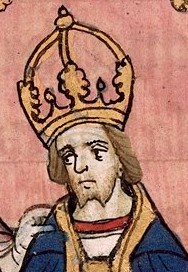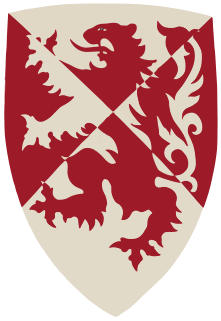Related Research Articles

Montalcino is a hill town and comune in the province of Siena, Tuscany, central Italy.

The Republic of Florence, officially the Florentine Republic, was a medieval and early modern state that was centered on the Italian city of Florence in Tuscany. The republic originated in 1115, when the Florentine people rebelled against the Margraviate of Tuscany upon the death of Matilda of Tuscany, who controlled vast territories that included Florence. The Florentines formed a commune in her successors' place. The republic was ruled by a council known as the Signoria of Florence. The signoria was chosen by the gonfaloniere, who was elected every two months by Florentine guild members.
Tuscany is named after its pre-Roman inhabitants, the Etruscans. It was ruled by Rome for many centuries. In the Middle Ages, it saw many invasions, but in the Renaissance period it helped lead Europe back to civilization. Later, it settled down as a grand duchy. It was conquered by Napoleonic France in the late 18th century and became part of the Italian Republic in the 19th century.

The Lunigiana is a historical territory of Italy, which today falls within the provinces of Massa Carrara, Tuscany, and La Spezia, Liguria. Its borders derive from the ancient Roman settlement, later the medieval diocese of Luni, which no longer exists.

The Republic of Lucca was a historic state of Italy, which lasted from 1160 to 1805 on the central Italian peninsula.

San Miniato is a town and comune in the province of Pisa, in the region of Tuscany, Italy.

Boniface III, son of Tedald of Canossa and the father of Matilda of Tuscany, was the most powerful north Italian prince of his age. By inheritance he was count of Brescia, Canossa, Ferrara, Florence, Lucca, Mantua, Modena, Pisa, Pistoia, Parma, Reggio, and Verona from 1007 and, by appointment, margrave of Tuscany from 1027 until his assassination in 1052.

The Republic of Pisa was an independent state centered on the Tuscan city of Pisa, which existed from the 11th to the 15th century. It rose to become an economic powerhouse, a commercial center whose merchants dominated Mediterranean and Italian trade for a century, before being surpassed and superseded by the Republic of Genoa.
Giordano d'Agliano, sometimes Giordano Lancia, was an Italian nobleman and military commander who served as marshal of the Kingdom of Sicily under King Manfred (1258–1266). He played a prominent role in the wars of the Guelphs and Ghibellines in Tuscany.

The March of Tuscany was a frontier march of the Kingdom of Italy and the Holy Roman Empire during the Middle Ages. Located in northwestern central Italy, it bordered the Papal States to the south, the Ligurian Sea to the west and Lombardy to the north. It comprised a collection of counties, largely in the valley of the Arno River, originally centered on Lucca.

Tuscany is a region in central Italy with an area of about 23,000 square kilometres and a population of about 3.8 million inhabitants. The regional capital is Florence (Firenze).

The battle of Colle di Val d'Elsa took place between 16 and 17 June 1269 at Colle di Val d'Elsa between the Ghibelline troops of Siena and the Guelph troops of Charles of Anjou and Florence, represented by fewer than 200 knights commanded by Neri de' Bardi.

Henry VII, also known as Henry of Luxembourg, was the King of Germany from 1308 and Holy Roman Emperor from 1312. He was the first emperor of the House of Luxembourg. During his brief career he reinvigorated the imperial cause in Italy, which was racked with the partisan struggles between the divided Guelf and Ghibelline factions, and inspired the praise of Dino Compagni and Dante Alighieri. He was the first emperor since the death of Frederick II in 1250, ending the Great Interregnum of the Holy Roman Empire; however, his premature death threatened to undo his life's work. His son, John of Bohemia, failed to be elected as his successor, and there was briefly another anti-king, Frederick the Fair, contesting the rule of Louis IV.
Conrad was the margrave of Tuscany from 1119/20 until 1129/31. He was a German, appointed by the Emperor Henry V to bring Tuscany back under imperial control. During the long Investiture Controversy, the Tuscan countess Matilda of Canossa had taken the ecclesiastical side against the emperor and imperial influence in the Tuscan margraviate was at low ebb upon her death in 1115. Conrad was the second in a series of 12th-century German appointees who proved too weak to restore imperial control and whose tenures are associated with the rise of self-government in the Tuscan cities—Florence, Genoa, Lucca, Pisa and Siena.

The Guidi were a Tuscan aristocratic family prominent in the region during the Middle Ages. Descended from Tegrimo Guidi, the family practised partible inheritance and in the thirteenth century began to split into separate cadet lineages.
The Tuscan League, also known as the League of San Genesio, was formed on 11 November 1197 at Borgo San Genesio by the chief cities, barons and bishops of the Duchy of Tuscany shortly after the death of the Emperor Henry VI. The league was the work of Pope Celestine III and his two papal legates: Pandulf, cardinal priest of Santi Apostoli, and Bernard, cardinal priest of San Pietro in Vincoli. It was directed against the Holy Roman Emperor in alliance with the papacy. Its members swore not to make any alliances without papal approval, nor to make any peace or truce "with any emperor, king, prince, duke or margrave" without the approval of the rectors of the league. The original signatories were the communes of Lucca, Florence and Siena, the people living under the castles of Prato and San Miniato, and the bishopric of Volterra. The city of Arezzo joined on 2 December; Pisa refused and was placed under interdict by Celestine.
The following is a timeline of the history of the city of Pisa in the Tuscany region of Italy.
The following is a timeline of the history of the city of Lucca in the Tuscany region of Italy.

The Republic of Siena in its progressive territorial growth saw its borders expanding especially in the territories of southern Tuscany in the current province of Grosseto. The possession of an "access to the sea" by Siena was therefore a natural continuation of its expansionary and commercial policy in the Maremma with the conquest of the ports of Talamone, Porto Ercole and Porto Santo Stefano.
References
- 1 2 3 4 5 Heywood, William (2010) [1921]. A History of Pisa: Eleventh and Twelfth Centuries. Cambridge University Press. pp. 96–97.
- 1 2 Wickham, Chris (2015). Sleepwalking into a New World: The Emergence of Italian City Communes in the Twelfth Century. Princeton University Press. p. 88.
- ↑ Rubinstein, Nicolai (1942). "The Beginnings of Political Thought in Florence: A Study in Mediaeval Historiography". Journal of the Warburg and Courtauld Institutes. 5: 198–227. doi:10.2307/750453.
- 1 2 3 4 Villari, Pasquale (1894). The Two First Centuries of Florentine History: The Republic and Parties at the Time of Dante. T. Fisher Unwin. pp. 102–07, 113.
- ↑ Schevill, Ferdinand (1963). Medieval and Renaissance Florence, Volume 1: Medieval Florence. Harper and Row.
- ↑ Dameron, George Williamson (1991). Episcopal Power and Florentine Society, 1000–1320. Harvard University Press. pp. 70–72.